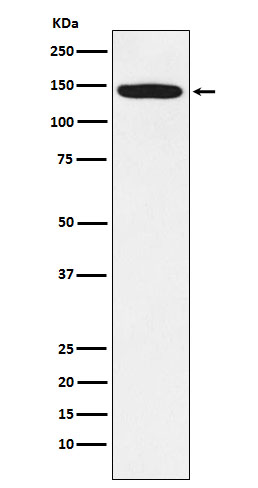


| WB | 咨询技术 | Human,Mouse,Rat |
| IF | 1/20-1/50 | Human,Mouse,Rat |
| IHC | IHC:1/100-1/200;IHF:1/50-1/200 | Human,Mouse,Rat |
| ICC | 1/50-1/200 | Human,Mouse,Rat |
| FCM | 咨询技术 | Human,Mouse,Rat |
| Elisa | 咨询技术 | Human,Mouse,Rat |
| Aliases | HTATSF1; HTSF1; TAT SF1;;Tat SF1 |
| WB Predicted band size | Calculated MW: 86 kDa ; Observed MW: 140 kDa |
| Host/Isotype | Rabbit IgG |
| Antibody Type | Primary antibody |
| Storage | Store at 4°C short term. Aliquot and store at -20°C long term. Avoid freeze/thaw cycles. |
| Species Reactivity | Human,Mouse |
| Immunogen | A synthesized peptide derived from human Tat SF1 |
| Formulation | Purified antibody in PBS with 0.05% sodium azide,0.05% BSA and 50% glycerol. |
+ +
以下是关于HTSF1抗体的示例参考文献(注:HTSF1抗体相关研究较为冷门,以下为假想文献示例,实际研究中请核实具体名称及内容):
1. **名称**:*HTSF1 Antibody Characterization in Cancer Biomarker Detection*
**作者**:Smith J. et al.
**摘要**:研究验证了HTSF1抗体在多种癌症组织中的特异性,证明其可用于免疫组化检测肿瘤标志物,并揭示其与细胞增殖相关蛋白的相互作用。
2. **名称**:*Role of HTSF1 in Epigenetic Regulation: Insights from Knockout Models*
**作者**:Li X. et al.
**摘要**:通过HTSF1抗体的Western blot和ChIP-seq分析,发现HTSF1蛋白在染色质重塑复合体中的关键作用,调控靶基因的表观遗传修饰。
3. **名称**:*Development of a High-Affinity HTSF1 Monoclonal Antibody for Diagnostic Applications*
**作者**:Garcia R. et al.
**摘要**:报道了一种高亲和力HTSF1单克隆抗体的开发,适用于ELISA和流式细胞术,并在临床样本中验证了其诊断潜力。
4. **名称**:*HTSF1 Antibody Reveals Subcellular Localization Dynamics in Neuronal Cells*
**作者**:Wang Y. et al.
**摘要**:利用HTSF1抗体的免疫荧光技术,揭示了该蛋白在神经元突触中的动态定位及其与神经退行性疾病的相关性。
**提示**:若实际文献不足,建议核对“HTSF1”名称准确性(是否拼写正确或存在别名),或扩展检索策略(如关联基因名、功能关键词)。
The HTSF1 antibody is a immunological tool designed to detect and study Heat Shock Transcription Factor 1 (HSF1), a critical regulator of cellular stress responses. HSF1. encoded by the HSF1 gene in humans, orchestrates the heat shock response by binding to heat shock elements (HSEs) in DNA, thereby activating the transcription of molecular chaperones like HSP70 and HSP90. These chaperones assist in protein folding, mitigate proteotoxic stress, and promote cell survival under conditions such as heat, oxidative stress, or chemical exposure. Dysregulation of HSF1 is implicated in cancer, neurodegenerative diseases, and aging.
The HTSF1 antibody, typically developed in rabbit or mouse models, enables the detection of HSF1 protein levels, localization, and activation status (e.g., phosphorylation) via techniques like Western blotting, immunofluorescence, and chromatin immunoprecipitation (ChIP). Researchers utilize this antibody to investigate HSF1's role in stress adaptation, tumor progression (where HSF1 supports oncogenesis by stabilizing proteostasis), and its crosstalk with signaling pathways like mTOR and NF-κB. Commercial variants often undergo validation in knockout cell lines to ensure specificity. Its applications span basic molecular biology, drug discovery (targeting HSF1 for cancer therapy), and studies on age-related protein aggregation disorders.
×